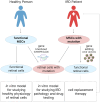Evaluation of mesenchymal stem cells as an in vitro model for inherited retinal diseases
- PMID: 39620144
- PMCID: PMC11604642
- DOI: 10.3389/fcell.2024.1455140
Evaluation of mesenchymal stem cells as an in vitro model for inherited retinal diseases
Abstract
Retinal pathologies are major causes of vision impairment and blindness in humans, and inherited retinal diseases (IRDs), such as retinitis pigmentosa, Leber congenital amaurosis, and Stargardt disease, greatly contribute to this problem. In vitro disease modeling can be used for understanding the development of pathology and for screening therapeutic pharmaceutical compounds. In the preclinical research phase, in vitro models complement in vivo models by reducing animal studies, decreasing costs, and shortening research timelines. Additionally, animal models may not always accurately replicate the human disease phenotype. This review examines the types of cells that can be used to create in vitro IRD models, including retina-specific cell lines, primary retinal cells, induced pluripotent stem cells (iPSCs), and more. Special attention is given to mesenchymal stem cells (MSCs), which are characterized by various isolation sources, relative ease of isolation, and straightforward differentiation. MSCs derived from bone marrow (BM), adipose tissue (AT), dental tissue (DT), umbilical cord (UC), and other sources can differentiate into retinal cells, including photoreceptor cells and retinal pigment epithelial (RPE) cells, dysfunction of which is most commonly associated with IRDs. Subsequent differentiation of MSCs into retinal cells can be carried out via various methods: culturing in induction media supplemented with certain growth factors, co-culturing with retinal cells or in their conditioned media, or regulating gene expression with viral vector-delivered transcription factors (TFs) or microRNAs (miRNAs). Compared to the popular iPSCs, for example, MSC-based models are significantly cheaper and faster to obtain, making them more feasible for large-scale drug screening. Nevertheless, the existing differentiation methods need further optimization for this promising platform to receive the success it deserves.
Keywords: IRD; MSC; in vitro disease modeling; inherited retinal diseases; mesenchymal stem cells; retinal cells.
Copyright © 2024 Dodina, Gurtsieva, Karabelsky and Minskaia.
Conflict of interest statement
The authors declare that the research was conducted in the absence of any commercial or financial relationships that could be construed as a potential conflict of interest.
Figures





Similar articles
-
Gene Therapy in Hereditary Retinal Dystrophies: The Usefulness of Diagnostic Tools in Candidate Patient Selections.Int J Mol Sci. 2023 Sep 6;24(18):13756. doi: 10.3390/ijms241813756. Int J Mol Sci. 2023. PMID: 37762059 Free PMC article. Review.
-
Gene therapy for inherited retinal diseases: progress and possibilities.Clin Exp Optom. 2021 May;104(4):444-454. doi: 10.1080/08164622.2021.1880863. Epub 2021 Mar 2. Clin Exp Optom. 2021. PMID: 33689657 Review.
-
Application of patient-derived induced pluripotent stem cells and organoids in inherited retinal diseases.Stem Cell Res Ther. 2023 Nov 27;14(1):340. doi: 10.1186/s13287-023-03564-5. Stem Cell Res Ther. 2023. PMID: 38012786 Free PMC article. Review.
-
Inherited Retinal Diseases and Retinal Organoids as Preclinical Cell Models for Inherited Retinal Disease Research.Genes (Basel). 2024 May 28;15(6):705. doi: 10.3390/genes15060705. Genes (Basel). 2024. PMID: 38927641 Free PMC article. Review.
-
Comparison of human mesenchymal stem cells derived from dental pulp, bone marrow, adipose tissue, and umbilical cord tissue by gene expression.Biomed Pap Med Fac Univ Palacky Olomouc Czech Repub. 2014 Sep;158(3):373-7. doi: 10.5507/bp.2013.078. Epub 2013 Oct 18. Biomed Pap Med Fac Univ Palacky Olomouc Czech Repub. 2014. PMID: 24145770
Cited by
-
Induced Pluripotent (iPSC) and Mesenchymal (MSC) Stem Cells for In Vitro Disease Modeling and Regenerative Medicine.Int J Mol Sci. 2025 Jun 11;26(12):5617. doi: 10.3390/ijms26125617. Int J Mol Sci. 2025. PMID: 40565081 Free PMC article. Review.
References
Publication types
LinkOut - more resources
Full Text Sources

